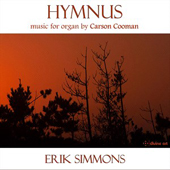

Haec Aeterna, Op. 118
Festive Processional, Op. 566
Arioso, Op. 1040
Pavane for a Duchess at St. Andrew 's, Op. 1070
Planctus IV, Op. 1071
Two Elegiac Pieces
Prelude in Copper, Op. 1060
Chorale semplice, Op. 1054
Folk Prelude, Op. 1020, "Azmon"
Aria quasi una ciaccona, Op. 1044
Partita semplice, Op. 1123
Three Enigmas, Op. 1110
Prelude, Op. 862, "Dix"
Hymnus, Op. 1036
Diptych, Op. 1007
I'm sure everyone would agree that there's nothing quite as sonically impressive as hearing a mighty J.S. Bach Prelude and Fugue, or a Widor Toccata played on a powerful pipe organ with all
stops open, including the 32' Bombarde pedal stops. In the appropriate acoustics you can practically feel the air displacement. But nothing beats the sound of a pipe organ displaying its "quiet"
side. One or two single stops per manual always reveal the beautiful tone, the soul, of a well built instrument. This recording contains a variety of short, quiet works for organ written
by Carson Cooman over the period from 1999 to 2015. Most of the pieces were written in memory of various individuals and are therefore mostly serene and contemplative,
and make full use of the 1787, Johann Nepomuk Holzhey organ of St. Peter & Paul, Weissenau, Germany's beautiful registration. It's plain to see that I've been rather impressed by some
(other recordings) of organist Erik Simmons performing the organ music of Carson Cooman, and this one is
no exception. Simmons instinctively knows which combination of stops is best suited to each individual piece based on its style, solemnity or character, and therefore brings together the organ's
tonal qualities and the music's anima to create an image of lasting impression.
This recording was produced in live performance via the Hauptwerk system, which involves MIDI and virtual models of actual instruments. It would take too long to explain clearly how this works,
but it is certainly worth your time to investigate it further. It's almost like being in two places at once, or rather like playing an instrument remotely in real-time. Quite fascinating!
Jean-Yves Duperron - January 2017